Chapter 26 Common Bonsai Styles
These are the generally recognized styles of bonsai trees. The Japanese names are in parentheses.
26.1 Classic Five Japanese Styles
Formal Upright (Chokkan): A primarily conifer style with a straight trunk, often with a powerful taper of the trunk.


Formal Upright (Chokkan) style. Link to original image 1; original image 2
Informal Upright (Moyogi): An upright trunk overall, but with some curve to it. Major branches are on the outside of the trunk curves and the apex is located directly over the basal root mass.


Informal Upright (Moyogi) style. Link to original image 1; image 2.
Slant (Shakan): A slanted trunk, with major branches on the outside of the trunk curves and the apex no longer located directly over the root mass at the base.


Slant (Shakan) style. Link to original image 1; original image 2
Partial Cascade (Han Kengai): A trunk that leans mostly horizontal to one side. Part of the foliage mass can hang down below the top lip of the pot.

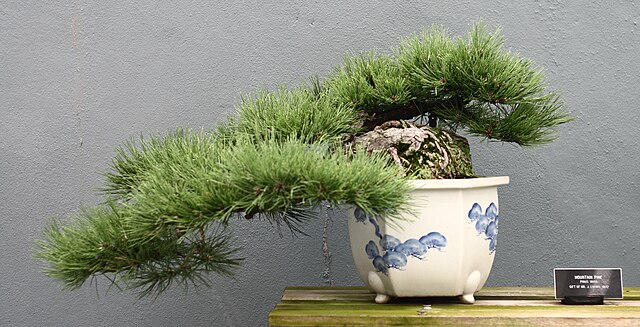
Partial Cascade (Han Kengai) style. Link to original image 1; original image 2
Full Cascade (Kengai): A trunk that falls below the pot rim, usually with curves in the trunk and branches extending from only the sides of the trunk.
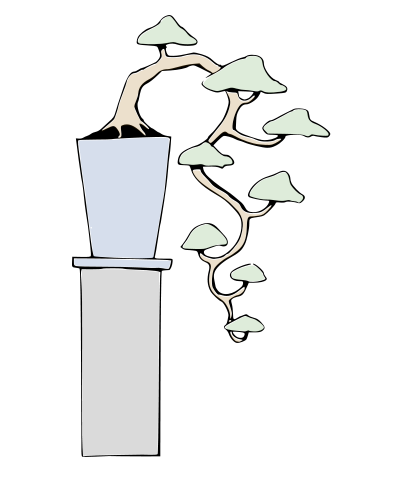

Full Cascade (Kengai) style. Link to original image 1; original image 2
26.2 More Recent and Specialized Styles
26.2.1 ”Sculptural” Styles
Literati or free style (Bunjin): At different times I have seen this style described as being inspired by: 1) Chinese calligraphic characters; 2) classical Chinese paintings showing a lone tree on a mountain; 3) one or more penjing styles; 4) karst formations shrouded in mist; 5) some mixture of 1-4. It is hard to describe, but once you see literati style, you recognize it easily.

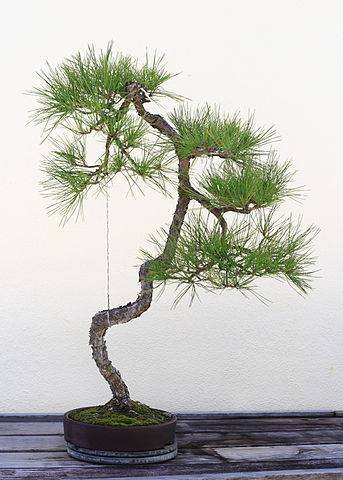
Literati or free style (Bunjin) style. Link to original image 1; original image 2
Literati intentionally breaks many traditional rules of proportion. Nearly all of the foliage is concentrated in a mass near the apex. The trunk is very long and has one or more strong bends providing movement. The root mass usually is contained in an under-sized circular pot (drum pot) rather than a traditional oval or rectangle. The asymmetric triangle of the tree is made up of trunk, foliage, and pot, not just by the tree’s foliage.
Broom (Kokidachi or Hokidachi): Broom style does not work with all species. Deciduous trees that naturally form a ball-shaped canopy (oaks, zelkova) can make very nice broom style bonsai. Like a literati, this style also breaks the traditional first-second-back branch rules. The trunk ends with a smaller number of branches of different diameters. Each branch quickly branches again, and those branches again. Repeated branching quickly leads to a thick canopy of finely ramified terminal branches.


Broom (Kokidachi or Hokidachi) style. Link to original image 1; original image 2
Exposed root (Neagari): Also sometimes called a stilt-root style. In nature trees in routinely flooded areas sometimes have the soils washed out from their roots, leaving the trunk of the tree suspended in the air. Mangrove trees alo grow in neagari style naturally.


Exposed root (Neagari) style. Link to original image 1; original image 2
Deadwood or driftwood (Sharimiki): A tree with a lot of dead wood as an important part of the design.

Deadwood or driftwood (Sharimiki) style. Link to original image
Twisted trunk (Nejikan): The entire trunk of the tree appears to be twisted in its long axis, similar to wringing out a wet towel. It is thought that this style is the one most similar to that of the first penjing trees that originally came to Japan from China.
Coiled trunk (Bankan): The trunk of the tree forms a loose spiral or coil, similar to a snake coiled around a large stick or branch. A coiled trunk may have a twist in it as well.


Coiled trunk (Bankan) style. Link to original image 1; original image 2
Windswept (Ukinagashi): A variation of the slanted style with most or all of its branches flowing in one diretion. The tree usually is bent 45° or more, and some branches may even cross from one side of the trunk to the other.


Windswept (Ukinagashi) style. Link to original image 1; original image 2
26.2.2 Multi-trunk Styles
Two trunk (Sokan): Two trunks from one root mass, with one trunk dominant. Sometimes called “father-son” or “mother-daughter” trees. Sometimes a “grove” planting of two individual trees will be called a “mother-daughter” style.


Two trunk (Sokan) style. Link to original image 1; original image 2
Clump (Kabudachi): An odd number of trees that appear to come from the same base.

Clump (Kabudachi) style. Link to original image
Raft (Ikada Buki): A group of trees that are really branches from one trunk laying on its side. This style imitates what might happen if a tree fell over but the branches on one side continued growing.

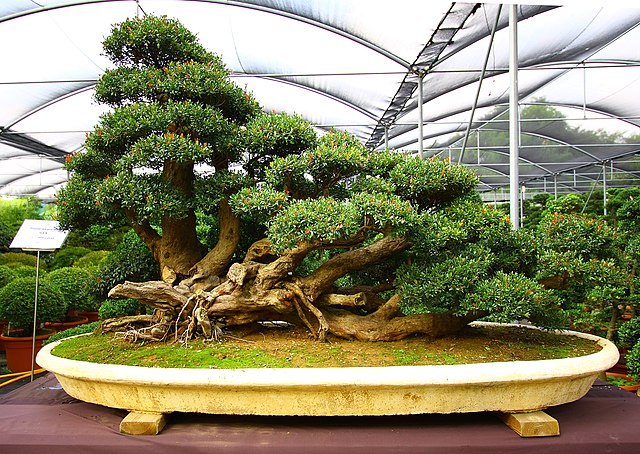
Raft (Ikada Buki) style. Link to original image 1; original image 2
Connected root (Ne Tsuranari) is very similar to raft style. It imitates separate trunks sprouting at intervals along a large root connecting the trees underground. This style is particularly good with trees like elms or crabapples that sprout easily from their roots. Other trees like maples that form root grafts naturally can be used too.
Grove/Forest (Yose-ue): A small group of individual trees. Groves usually have either 2 trees or an odd number of trunks.
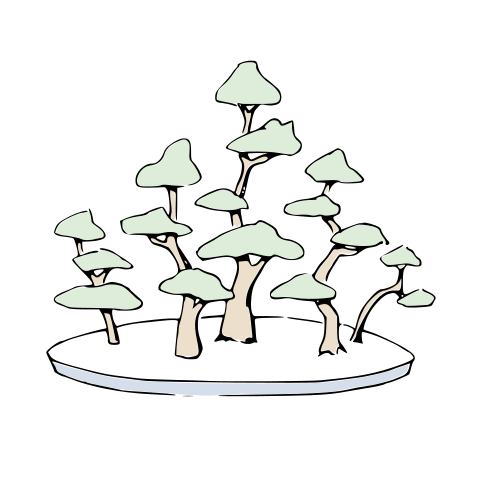

Grove/Forest (Yose-ue) style. Link to original image 1; original image 2
26.2.3 Styles With Landscape Elements
Tree on a rock (Ishitsuki): The entire root mass of a tree is planted in a cavity or depression on a large rock. Often includes smaller plants and moss.


Tree on a rock (Ishitsuki) style. Link to original image 1; original image 2
Root over rock (Sekijoju): The tree is planted so large woody roots hold a large rock tightly until both roots and rock disappear below ground. Sometimes, the color of the rock or the grandeur of the roots, are the main competitors to the enhancement of the whole.

Root over rock (Sekijoju) style. Link to original image 1; original image 2
Miniature scenes (Saikei): Combinations of trees, smaller plants, rocks, mosses, etc., to create complete natural scenes


Saikei (miniature scene) style. Link to original image 1, image 2
